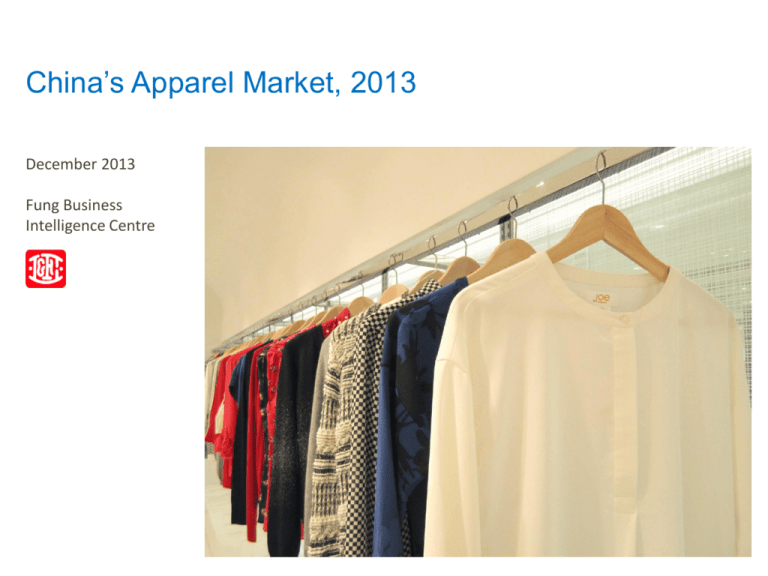
China’s Apparel Market, 2013
December 2013
Fung Business
Intelligence Centre
Table of contents
Market overview
4
Competitive landscape
14
Distribution channels
20
Key highlights
30
Snapshots of sub-sector
38
2
Executive summary
Today, China’s apparel market is one of the fastest growing markets in the world. The rise of
e-commerce and the boom in fast fashion have fuelled the fast growth of the market in
recent years.
Department stores and specialty stores are the major distribution channels for apparel in
China. Meanwhile, online retailing is growing fast. More online apparel retailers offer a wide
variety of clothes at discounted prices. Moreover, fast delivery and easy return policy make
online retailing more appealing to consumers, especially those younger and tech-savvy ones.
With better online shopping environment, online sales are set to continue to fuel the
development of China’s apparel market.
Leading international fast fashion players such as H&M, ZARA, and Forever 21, are all
expanding fast in the country. With the rapid growth of the urban middle class, the demand
for fast fashion is increasing. Fast fashion brands are often welcomed by many department
stores and shopping malls as they can draw foot traffic.
Under the current sluggish domestic economic conditions, the majority of mass consumers
are still price-sensitive. However, premiumisation will be the theme when consumers are
becoming more sophisticated. Also, facing the challenges from international fast fashion
players, domestic apparel players are finding their way out by upgrading themselves.
3
Market overview
4
Market overview
China’s apparel market is fast-growing; consolidation is gathering pace
China’s apparel market is today one of the fastest growing markets in the world.
Retail sales value continued to soar in 2012, albeit slightly slower growth against 2011.
−
According to the National Bureau of Statistics of China (NBS), the total retail sales of clothing, shoes, hats and textiles* by
enterprises above designated size** in 2012 rose nominally by 18.0% year-on-year (yoy), slowing from 24.2% yoy growth
in 2011.
Unit price continued to rise
−
−
According to the NBS, the clothing price index has increased by 3.1% yoy in FY2012, higher than FY2011 of 2.1% yoy.
However, since September, the price increase was decelerated due to the heavy promotions of the apparel enterprises.
Exhibit 1: Total retail sales of clothing, shoes, hats and textiles
by enterprises above designated size, 2008 - 2012
1,200
25.9%
24.8%
30.0%
24.2%
1,000
795.5
18.8%
800
977.8
18.0%
400
377.6
103.4
103.5
20.0%
103.0
462.2
10.0%
2009
Billion yuan
2010
2011
yoy growth (%)
102.5102.5
102.3
102.3102.2102.2102.3
102.1
102.5
102.5
0
Source: NBS
102.7
15.0%
200
2008
104.0
25.0%
587.4
600
Exhibit 2: Monthly clothing price index, September 2012 –
September 2013
5.0%
102.0
0.0%
101.5
102.3
101.9
2012
101.0
Source: NBS
*“Clothing, shoes, hats and textiles” replaced the previous “clothing” category in the NBS announcement in 1-3Q09
** Enterprises above designated size refer to enterprises with annual sales of 5 million yuan or above and with an employment of or over 60.
5
Market overview
China’s apparel market is fast-growing; consolidation is gathering pace (Cont’d)
Operating costs such as retail rentals climb and competition stiffens, which put more pressure
on apparel players.
The inventory problem in 2011 was eased a bit in 2012 due to the better economic
performance and an overall increase in consumption.
Exhibit 3: Inventory level of enterprises above designated size, 1Q12 – FY12
20%
18.48%
14.37%
15%
12.25%
9.46%
10%
5%
0%
1Q12
1H12
1-3Q12
FY12
Source: NBS
Market consolidation is now gathering pace. Apparel retailers with distinctive brand
positioning, responsive supply chains, effective distribution and pricing strategies will stand
out from the rest.
6
Market overview
Annual expenditure on clothing increased steadily
Urban households
−
−
Rural households
−
−
The annual per capita net income of rural residents grew by 10.7% yoy to reached 7,917 yuan in 2012.
Rural households spent 396.1 yuan on clothing in 2012, accounting for 7.3% of the total annual expenditure.
Exhibit 4: Per capita annual expenditure on clothing* of urban and rural households, 2008 - 2012
2,000
10.37
10.47
10.72
11.05
10.94
1,000
12.0
10.0
1,500
Yuan
The annual per capita disposable income of urban households grew by 9.6% yoy to 24,565 yuan in real terms in 2012.
Urban households spent 1,823.4 yuan on clothing in 2012, accounting for 10.9% of the total annual expenditure.
6.68
6.62
7.21
6.83
7.32
8.0
6.0
%
4.0
500
2.0
0
0.0
2008
2009
2010
2011
2012
Per capita urban annual expenditure on clothing
Per capita rural annual expenditure on clothing
Share of clothing in per capita urban annual expenditure
Share of clothing in per capita rural annual expenditure
Source: NBS
7
Market overview
Ladies’ wear is the largest sector
Ladies’ wear is the major contributor to total apparel sales and volume according to a report
by the China National Commercial Information Centre (CNCIC)*.
Exhibit 5: Retail sales volume of selected apparel categories in
100 major retailers in China, 2012 – 1H2013
2012
Exhibit 6: Retail sales of selected apparel categories in 100
major retailers in China, 2012 – 1H2013
1H2013
2012
Million pieces
yoy %
growth
Million pieces
yoy %
growth
Men’s suit
6.88
9.62
4.07
10.65
Men’s shirt
5.40
-8.90
2.75
T-shirts
6.34
-12.51
Ladies’ wear
86.24
Children’s wear
1H2013
Retail sales
(billion yuan)
yoy %
growth
Retail sales
(billion yuan)
yoy %
growth
Overall
116.27
12.33
61.15
6.85
-6.28
Menswear
23.43
11.09
11.91
1.76
2.61
-13.73
Ladies' wear
34.98
13.12
18.13
7.37
7.54
46.61
6.44
Children's wear
3.06
15.34
1.66
11.49
20.65
3.19
12.48
16.86
Denim wear
2.51
-11.75
1.12
-13.62
Jackets
3.11
5.33
1.66
-4.89
Thermal clothing
5.56
-5.74
2.34
-11.64
Leather wear
0.72
11.51
0.39
19.16
Trousers
5.84
-4.42
3.00
-6.54
Knitted
underwear
31.56
1.16
16.19
-2.55
Woolen wear
11.88
-8.45
6.48
2.44
Source: CNCIC
Source: CNCIC
* The China National Commercial Information Centre (CNCIC) monitors monthly sales of selected sectors in 100 major retailers.
8
Market overview
Children’s wear and outdoor wear have the largest growth potential
The market for men’s formal wear and sportswear are comparatively more mature. Growth
slows and the competition is getting intense.
On the other hand, children’s wear, particularly babies’ wear, and outdoor wear have a
larger growth potential. In the meantime, competition is still limited.
Exhibit 7: Forecast for selected apparel categories
Apparel category
Men's formal wear
Growth forecast
(CAGR 2012-2016)
8-10%
Sportswear
10%
Women's casual wear
15%
Men's casual wear
17%
Babies' wear
20-25%
Outdoor wear
20-30%
Note: Sportswear excludes footwear and accessories; outdoor wear exclude footwear and equipment.
Sources: A.T. Kearney, “Winning China's Apparel Market”, May 2013
9
Analysis of sub-sectors
Ladies’ wear: Foreign fast fashion brands are expanding fast
Purchasing power of women has been increasing significantly in the past years and consumers
are trading up. Consumers aged 20-35 are especially willing to spend on apparel.
Ladies’ wear market is highly segmented - casual wear, fashion for young ladies, fashion for
mature women, fast fashion, business casual, high-end fashion, etc.
Fast fashion market is growing fast. Consumers are becoming more familiar with international
fast fashion brands which offer stylish clothes at affordable prices.
−
Foreign fast fashion leaders H&M, ZARA, Uniqlo, and Forever 21 have been expanding rapidly in the China market,
starting first in tier-1 cities and gradually penetrating into lower-tier cities.
• Around 2/3 of ZARA’s stores are located in the tier-2 and tier-3 cities as of 2012.
• H&M management said China will soon replace Germany as H&M‘s largest overseas market.
10
Analysis of sub-sectors
Menswear: Slowing; designs are growingly fashionable
Growth of menswear market is slowing and market share is diminishing.
However, business causal wear is increasing in popularity, and the design is more fashionable
than ever before. Apparel companies that specialized in business causal wear such as
Septwolves, JOEONE, and Lilang are witnessing increasing sales growth.
Similar to ladies’ wear, fast fashion for men is gathering pace.
11
Analysis of sub-sectors
Children’s wear: Strong growth momentum; consumers are brand-conscious
Population of children aged 0-14 years totaled 222.87 million in 2012, accounting for around
16.5% of the total population in China. The Chinese leaders have just relaxed the national
“one-child policy”, allowing couples to have two children if one spouse is an only child. China
is expected to add 1-2 million extra kids over the next few years. This certainly is good news
for retailers of children’s wear market.
As income levels rise, Chinese parents are now more willing to spend money to make their
children look fashionable. Consumers are generally more brand-conscious and drifting
towards fashion and lifestyle brands. Children’s wear made from soft and comfortable
materials and casual children’s sportswear with cozy fabrics and loose-fitting designs have
become the market trend.
Although consumption needs have gradually switched from practical considerations to
aesthetic and fashion considerations, the majority parents in China still look for “value for
money” products.
Competition in the children’s wear sector is getting fierce. Many apparel brands have tried to
ride the booming children’s wear market by extending their product lines.
−
−
Foreign examples: Baby Dior, D&G Baby, ARMANI Junior, Gucci
Domestic examples: Xtep, Anta, 361 Degree, Li Ning, Stepwolves, Baoxiniao, JNBY, GXG
12
Analysis of sub-sectors
Sportswear: Highly concentrated but slowing market; competition is fierce
Sportswear market in China is a relatively concentrated and mature sub-sector.
Domestic sportswear brands are dominating the lower-tier cities while international brands
are mainly concentrated in tier-1 and tier-2 cities. However, leading players such as Nike and
Adidas are adjusting their market strategies and paying more attention to the lower-tier cities.
Cut-throat competition in sportswear is expected to set off.
Recently, overstocks of obsolete inventory have troubled some leading domestic sportswear
companies. Overstocking was largely attributable to irrational business expansion of some
players in recent years. Many have rolled out aggressive expansion plans in terms of retail
outlets and product portfolio expansion as well as investment in marketing campaigns and the
products they offer are highly similar to each other. Hence, sportswear suffered from a big
slowdown in sales growth in 2012.
−
Domestic players Li Ning, Anta, 361 Degree, Xtep, and Peak all suffered from sales declines in 2012 of -17%, -18%, -15%,
-12% and -29% in 2012 respectively.
13
Competitive landscape
14
Competitive landscape
Domestic brands dominate the mass market
Domestic brands dominate the mass market, especially in lower-tier cities and the rural
market. Generally they have more extensive sales channels than their foreign counterparts.
Exhibit 8 and 9 show the top 10 domestic apparel enterprises by sales revenue and profits in
2012. Most enterprises in the list are from Jiangsu, Shandong and Shanghai.
Exhibit 8: Top 10 domestic apparel enterprises by sales
revenue, 2012
Ranking
Company
1
Youngor Group Co., Ltd 雅戈爾集團股份有
限公司
Hongdou Group Co., Ltd 紅豆集團有限公
司
Heilan Group 海瀾集團有限公司
2
3
4
5
6
7
8
9
10
ShanShan Enterprise 杉杉投資控股有限公
司
Bosideng Co., Ltd 波司登股份有限公司
Shandong Ruyi Science & Technology
Group 山東如意科技集團有限公司
Qingdao Jifa Group 青島即發集團
Shandong Sinoer Group Co., Ltd. 新郎希
努爾集團股份有限公司
China Ballon Apparel Group 巴龍集團有限
公司
Weixing Group 偉星集團有限公司
Exhibit 9: Top 10 domestic apparel enterprises by profits,
2012
Headquarter/
Base
Ningbo
(Zhejiang)
Wuxi
(Jiangsu)
Wuxi
(Jiangsu)
Shanghai
Ranking
Company
1
Bosideng Co., Ltd 波司登股份有限公司
2
Youngor Group Co., Ltd 雅戈爾集團股份
有限公司
Heilan Group 海瀾集團有限公司
4
China Ballon Apparel Group 巴龍集團有
限公司
Qingdao
(Shandong)
Suzhou
(Jiangsu)
Jining
(Shandong)
Qingdao
(Shandong)
Weifang
(Shandong)
5
Wuxi (Jiangsu)
Qingdao
(Shandong)
Taizhou
(Zhejiang)
9
Hongdou Group Co., Ltd 紅豆集團有限公
司
Shandong Sinoer Group Co., Ltd. 新郎希
努爾集團股份有限公司
Semir Group Co., Ltd. 浙江森馬集團有限
公司
Dongdu Textile Group 江蘇東渡紡織集團
有限公司
Shandong Ruyi Science & Technology
Group 山東如意科技集團有限公司
Taizilong(Holdings) Group Ltd. 太子龍控
股集團有限公司
3
6
7
8
10
Headquarter/
Base
Suzhou
(Jiangsu)
Ningbo
(Zhejiang)
Wuxi (Jiangsu)
Weifang
(Shandong)
Shanghai
(Jiangsu)
Jining
(Shandong)
Zhejiang
Source: China National Garment Association (CNGA), compiled by Fung Business Intelligence Centre
15
Competitive landscape
Domestic brands dominate the mass market (Cont’d)
Exhibit 10: Most Valuable Apparel Brands in China, 2013
Rank in Rank in
2013
2012
Brand
Brand Value
(billion yuan)
% of
Market
Value
Product
catogory
Headquarter
1
3
Anta 安踏
4.0
30%
Sportswear
Xiamen
(Fujian)
2
1
Metersbonwe 美特斯
邦威
3.8
32%
Casual wear
Shanghai
3
4
Bosideng 波司登
3.8
25%
Down wear
Suzhou
(Jiangsu)
4
2
Semir 森馬
3.7
28%
Casual
wear/Children
wear
Shanghai
5
5
Septwolves 七匹狼
2.0
25%
6
15
Aokang 奧康
1.9
27%
6
6
Joeone 九牧王
1.9
22%
6
9
Youngor 雅戈爾
1.9
23%
9
7
Heilan 海瀾之家
1.8
25%
10
N/A
Fuanna 富安娜
1.7
30%
Home textile
Shenzhen
11
N/A
Luolai 羅萊
1.5
27%
Home textile
Shanghai
12
8
Lining 李寧
1.4
35%
Sportswear
Beijing
12
11
Xtep 特步
1.4
25%
Sportswear
Quanzhou
(Fujian)
Xiamen
(Fujian)
Wenzhou
Leather shoes
(Zhejiang)
Quanzhou
Menswear
(Fujian)
Ningbo
Menswear
(Zhejiang)
Wuxi
Menswear
(Jiangsu)
Exhibit 10 shows China’s most valuable
apparel brands in the Hurun Most
Valuable Chinese Brands 2013 list. The
number of apparel brands decreased
from 17 in 2012 to 13 in 2013.
Anta has replaced Metersbonwe to top
the list of the most valuable Chinese
apparel brand. Its brand value amounted
to 4.0 billion yuan in 2013.
Fuanna and Luolai are new entrants in
the 2013 ranking.
Most of the brands in the list are
specialized in the menswear and
sportswear, while the two new entrants
are specialized in home textile.
Apparel companies in Fujian and
Zhejiang are very strong in branding; 6
out of the top 13 most valuable apparel
brands are based in these two provinces.
Menswear
Source: Hurun Research Institute, compiled by Fung Business Intelligence Centre
16
Competitive landscape
Domestic brands expand overseas to seek new growth opportunity
The domestic apparel industry has suffered sluggish development due to the slowing global
economy and rising costs. Chinese apparel retailers are increasingly active in expanding
overseas to maintain growth.
A number of apparel retailers have opened stores in overseas markets in recent years.
−
Metersbonwe opened a flagship store in London in July 2013, and plans to open more stores in Paris, New York and
Tokyo within 3 years*.
Some retailers seek to enlarge market share by engaging in M&A activities.
−
As part of its expansion into Europe beginning with the UK, Bosideng is set to acquire UK retailer Greenwoods
Menswear for approximately 40 million yuan**. Bosideng widens its men’s wear operations in the UK and unveil its
down jacket lines to the UK consumers with the newly acquired store fronts provided by Greenwoods.
* http://www.linkshop.com.cn/web/archives/2013/266539.shtml
** http://www.chinagoabroad.com/en/deal/other/bosideng-acquire-uk-mens-wear-firm-greenwoods-rmb-40-million
17
Competitive landscape
Foreign brands are more popular in the mid- to high-end market
In general, domestic brands dominate the mass market while foreign brands are usually more
popular in the mid- to high-end market. Consumers with higher apparel budgets, and those
living in tier-1 and tier-2 cities are more likely to buy foreign brands. However, this may be
attributed to fewer choices of foreign brands in lower-tier cities.
According to CBRE, in terms of store numbers, China has already become the most important
international market for major fast fashion brands. It is the largest international market for
ZARA and Uniqlo, and the largest international market in Asia for H&M and C&A. Exhibit 11
shows the store count of the four major fast fashion brands in China during from 2010 to June
2013.
Exhibit 11: Store count of fast fashion brands in China, 2010-1H13
0
50
100
150
200
250
Uniqlo
211
2010
ZARA
2011
125
2012
1H13
H&M
135
C&A
52
Source: CNCIC, CBRE, company websites; compiled by Fung Business Intelligence Centre
18
Competitive landscape
Foreign brands dominate the luxury apparel market
Foreign players dominate China’s luxury apparel market. According to the Hurun’s Chinese
Luxury Consumer Survey 2013, the most popular brands among Chinese millionaires were all
foreign brands as shown in Exhibit 12 and 13.
Exhibit 12: The most popular female brands among
Chinese millionaires, 2013
1
2
3
Brand
Chanel
Burberry
Dior
1
2
3
Brand
Giorgio Armani
Ermenegildo Zegna
Hugo Boss
4
Giorgio Armani
4
Burberry
5
6
7
8
9
Ports
Gucci
LV
Versace
Givenchy
5
6
Versace
Dunhill
Source: Hurun, “Chinese Luxury Consumer Survey 2013”, January 2013
Exhibit 13: The most popular male brands among
Chinese millionaires, 2013
Source: Hurun, “Chinese Luxury Consumer Survey 2013”, January 2013
Domestic players only have minimal presence in the luxury market. NE·TIGER is one of the
domestic luxury brands that has a nationwide awareness.
19
Distribution channels
20
Distribution channels
Department stores and specialty stores - the main channels for apparel
distribution
Department stores and specialty stores remained the main channels for apparel distribution
in 2012, accounting for 36.8% and 28.5% of market share respectively.
Other emerging new retail formats such as discount stores, outlets, and multi-brand stores
are gaining increasing attention in recent years. Online retailing channel is also growing fast.
Exhibit 14: Sales of Apparel by Distribution Format, 2012
Other nongrocery retailers,
1.20%
Non-store
retailing, 7.50%
Leisure &
personal goods
specialist
retailers, 10.50%
Department
stores, 36.80%
Grocery retailers,
15.50%
Apparel specialist
retailers, 28.50%
Source: Euromonitor, “Apparel in China”, May 2013
21
Department stores
Main channel for mid-to high-end apparel; facing increasing challenges
from other retail formats
Department stores are still the main channel for mid- to high-end apparel. Usually around
50% of the total revenue of department stores come from apparel sales.
Many department store operators in China adopt the concessionary operating model.
−
−
−
Commission rates for most department stores on apparel is around 20% depending on the positioning of brands.
Pitfalls: poor differentiation of department stores
According to Guangdong Academy of Social Sciences, brand overlapping rate for apparels, shoes and cosmetics among
the surveyed department stores in Guangzhou reached 41.5%, 41.3% and 45.8% in 2012, respectively.
Offline and online integration is increasingly popular. Facing the fast growing online market,
many apparel brands have launched their own online shops (e.g. Banggo.com by
Metersbonwe) or have started to operate a shop on third-party online B2C platforms such as
Tmall.
22
Department stores
Main channel for mid-to high-end apparel; facing increasing challenges
from other retail formats (Cont’d)
In recent years, department store operators are facing fierce competition from shopping
malls, specialty stores, and online stores. To survive and trump the competition, many
department store operators have embarked on multiple strategies to enhance core
competence.
−
−
−
Reviewing their merchandise mix more frequently
Launching private labels/ proprietary brands
Refining their market positioning strategies to cater to specific customer demographics
• Wanda Department Store is reportedly planning to open three luxury department stores in Wuhan, Taiyuan and
Changsha.
• Beijing Wangfujing Department Store (Group) Co Ltd has introduced its sub-brand hQ (hQ 尚客) to target
younger and trendy consumers.
• Dalian Dashang has opened Mykal (麥凱樂) to target higher-end consumers and Kingson Department Store (千
盛百貨) to target trendy youngsters.
23
Specialty stores
Increasingly preferred by brand owners
Specialty stores are increasingly preferred by apparel brand owners.
When operating specialty stores, brand owners can have more control over price, promotion activities and
store design and layout, and thus can better deliver their brand message to customers and provide them a
unique shopping experience. Specialty store operators are usually more profitable than concessionaires in
department stores as they do not have to pay high commissions.
A majority of apparel brand owners and manufactures in China adopt a combination of both self-operated
stores and franchised stores. Very often, they manage the stores in key cities or strategic/ profitable
locations directly while leaving other locations to franchisees as distributors.
Direct-operated stores are more efficient when compared with franchise stores. Normally, the average
sales per store of direct-operated stores is higher than that of franchise stores. Direct-operated stores are
also better managed than franchise stores in terms of visual merchandizing, image control, and price
control.
In general, the more high-end the brands are, the more likely the brand owners will directly control the
stores. However, it is relatively more costly to run direct-operated stores because of the higher capital
expenditure (CAPEX) and higher rental costs in key cities.
According to Euromonitor, outlet growth for apparel specialist retailers has been impressive, at almost 10%
in 2012, the highest among all distribution channels in China. The number of outlets of apparel specialist
retailers amounted to 512,800 in 2012.
24
Hypermarkets/ supermarkets
Target at lower- to middle-mass
Hypermarkets and supermarkets offer comprehensive range of products covering non-food
and food items, providing shoppers with a one-stop shopping environment. Most
hypermarkets are located in shopping malls near residential areas and in city centres. The
popularity of hypermarkets stems from its low price appeal.
Hypermarkets and supermarkets are popular retailing channels for lower-priced apparel;
many of which are with poor brand recognition or unbranded. Unit price is generally lower
than that in department stores.
Their target customers are those who always purchase daily necessities and look for
convenience in buying apparel in a one-stop shopping environment.
25
Online retailing
Fastest growing retail channel in China for apparel
Online retailing is the fastest
growing retail channel for apparel
in China. It is observed that many
consumers are shifting their
apparel spending offline to online.
−
According to iResearch, the total
online apparel transaction value
in China grew remarkably by 56%
yoy to reach 318.9 billion yuan in
2012.
Exhibit 15: Online apparel sales, 2008 – 2016 (estimates)
1000
180%
166%
920.0
900
160%
800
119%
700
120%
600
“Showrooming”
is becoming
increasingly popular. Physical
stores in shopping malls and
department stores have now
more or less become the “fitting
rooms” for consumers to try on
products before they purchase
online.
567.9
95%
500
140%
727.4
126%
100%
56%
400
429.1
80%
318.9
60%
300
204.9
35%
200
32%
28%
27%
40%
20%
105.2
100
0
18.1
14%
2008
48.0
18%
23%
27%
27%
27%
27%
28%
28%
2009
2010
2011
2012e
2013e
2014e
2015e
2016e
0%
Online apparel sales (billion yuan)
Share of the total online retail sales (%)
Growth (% yoy)
Source: iResearch, "China Online Clothing Shopping Research", January 2013
26
Online retailing
Ladies’ wear is the most popular sub-category consumers purchased online
Apparel was the largest contributor among all
categories and accounted for 27% of the total
online sales in China.
Exhibit 17: Online apparel sales by category, 2012
Others, 13.8%
Ladies' wear,
41.1%
Sportswear and
outdoor wear,
6.3%
Exhibit 16: The most popular categories consumer
purchased online, 2012
Homewear, 3.7%
Apparel, bags
and accessories,
26.5%
Maternity,
babies' and
children's wear,
5.1%
Others, 42.7%
Footwear, hats
and accessories,
12.5%
Menswear,
17.6%
Source: iResearch, "China Online Clothing Shopping Research", January 2013
Consumer
electrionics,
18.4%
Books, music
and videos, 3.0%
Maternity and
babies' products,
4.4%
Among all the apparel items purchased online,
ladies' wear was the most popular category,
with a market share of 41.1% in 2012.
The “maternity, babies’ and children’s wear”
category is expected to become the next
growth driver for online retailers.
Cosmetics
products, 5.0%
Source: iResearch, "China Online Clothing Shopping Research", January 2013
27
Online retailing
The C2C segment represents the largest segment for China’s online apparel
retailing; but the B2C segment is becoming increasingly important
The C2C segment represents the largest
segment for China’s online apparel retailing. But
the B2C segment is becoming more and more
important.
Exhibit 18: Share of online apparel retailing in terms of
transaction value, 2011-2012 (estimates)
100%
Exhibit 19: Market share of B2C Apparel market, 2012
Mbaobao, 0.6%
Dangdang, 0.7%
Okbuy, 0.8%
Others, 7.1%
M18, 0.9%
V+, 1.0%
Amazon China,
1.1%
Moonbasa, 1.4%
6.30%
Vipshop, 1.8%
90%
13.70%
80%
70%
22.00%
B2C self-operated
retailers
Suning , 2.2%
Tencent B2C
platform, 2.8%
16.80%
JD.com, 6.6%
Vancl, 7.2%
60%
Tmall, 66.0%
B2C platforms
50%
40%
30%
C2C platforms
Source: iResearch, "China Online Clothing Shopping Research", January 2013
20%
10%
79.90%
61.20%
2011
2012
0%
Source: iResearch, "China Online Clothing Shopping Research", January 2013
With a market share of 66%, Tmall is the
absolute market leader in the B2C segment for
apparel retailing. Vancl and JD.com come
second and third, with 7.2% and 6.6% market
share respectively.
28
Online retailing
The millennial consumers are the major online apparel shoppers
The millennial generation is the most frequent online shoppers and online shopping has
increasingly become a way of life for many of them. Diversity of choice, lower prices and
convenience in terms of payment flavor younger consumers to spend their extra money
buying clothes online.
Deloitte’s survey results show that consumers aged 20-30 spend the most on apparel online,
female consumers spend more than male consumers.
Exhibit 20: What proportion of your total apparel purchasing is done online?
(Survey 2012, n = 1566*)
29
* Note: Number of respondents who are sure about their online purchasing percentage
Source: Deloitte, "China's consumer markets", June 2013
29
Key highlights
30
Existing adult-focused apparel retailers are flocking to the
children’s wear market
China’s consumer expenditure on children’s wear per household have been
increasing significantly. Seeing the promising outlook of the children’s market,
existing adult-focused apparel retailers have flocked to the lucrative segment in
recent years.
−
−
−
Domestic players in men’s and women’s apparel such as Septwolves, Metersbonwe and Semir have
already set foot in the children’s wear market by offering children’s wear product lines.
Sportswear retailer Li Ning also introduced a sub-brand “Li Ning Kids” in 2010; the retailer expected
to reach a store expansion rate of 40% yoy in 2013.
Multinational luxury brands D&G, Armani and Burberry all launched children’s wear series in China in
2011 following Dior’s successful rollout of its “Baby Dior” series in the country in April 2010.
31
Outdoor wear market is still in its infancy but seeing huge
potential
China’s outdoor wear market is in its infancy. According to A.T. Kearney, only around 5% of
the population engage in outdoor sports (compared to 50% in the United States). Having said
that, it is observed that outdoor sports is gaining popularity in China; meanwhile consumers
are buying outdoor apparel for everyday use, favoring their comfort and functionality.
Currently, the outdoor sports market in China is largely dominated by a few foreign brands
such as The North Face, Columbia, and Jack Wolfskin. Most other new players still have very
small market shares.
32
Department store operators launch their own private apparel
labels or proprietary brands
Launching private labels or proprietary brands is a good way for retailers to build core
competence. Private labels or proprietary brands may also increase profit margins and
improve customer loyalty.
−
−
−
−
Wangfujing Department Store unveiled a new store brand “Fashion Headquarters” in Beijing in September 2010
targeting fashion consumers aged 18-35.
Guangzhou Grandbuy Department Store launched a new store brand “Grandbuy Fashion” (GBF) in G.T. Land Plaza in
Guangzhou in December 2010 targeting the youth segment.
New World Department Store launched its private labels “XII” and “N Only” in 2010.
Intime Department Store launched another proprietary brand “Mangano” in West Lake Intime Department Store in
September 2012 after introducing “Justin Intime” in 2009.
However, private labels in China are not that successful in terms of revenue generated and
popularity among consumers.
−
−
−
−
−
Many Chinese department store operators reflected that they lack professional and experienced buyers to select
appropriate products
Retailers do not have the knowledge on manufacturing and marketing their own product lines.
The capital investment is huge.
Department stores have to hold inventories and incur more risks than operating under the current concessionaire
model.
The operating model is very different, which requires another type of management skills.
33
Shifting from aggressive store expansion to improving store
productivity
Some apparel retailers have adopted aggressive expansion strategy to boost brand visibility in
the past. However, they now find that many stores are unprofitable.
Facing the slowing growth of the whole apparel market, some brands owners have started to
close the unprofitable stores and focus on improving their core competence
−
It was reported that Mango has closed nearly 40% of the stores in China, contracting from 200 stores in end-2012 to
less than 120 stores in 2013. On the other hand, it has announced a new retailing model focused on megastores, and
its first megastore in China will soon be located in Shanghai.
Ways to improve core competence
−
−
−
−
−
To upgrade themselves by investing more on R&D
To launch more long-term marketing campaigns for brand building
To introduce new store brands and retail concepts
To launch differentiated merchandise assortments
To accelerate format revamps and innovation
34
Lower-tier cities become the major battlefields for apparel
enterprises
Competition in tier-1 and tier-2 cities has become fiercer, and the market is gradually
saturated. Many apparel brands have shifted their focus to lower-tier cities to avoid toe-totoe competition. Meanwhile, new supply in the core areas of these cities is limited.
−
−
For instance, Adidas and H&M have announced plans to increase their presence in lower-tier cities by 2015.
Fast fashion brands continued to increase their presence in tier-2 and tier-3 cities (see Exhibit 21 and 22).
Exhibit 21: Proportion of number of stores in tier-1, 2 and 3
cities of the 4 key fast fashion brands* in China, December
2011
Tier-3 cities,
24.10%
Exhibit 22: Proportion of number of stores in tier-1, 2 and 3
cities of the 4 key fast fashion brands in China, June 2013
Tier-3
cities,
27.90%
Tier-1 cities,
41.10%
Tier-2 cities,
34.80%
Source: CBRE, “China retail: A changing landscape”, October 2013
Tier-1
cities,
35.40%
Tier-2
cities,
36.70%
Source: CBRE, “China retail: A changing landscape”, October 2013
New marketing strategies may be necessary to target consumers in lower-tier cities. Brands
that are trying to get in the market will also be confronted with new challenges, such as
managing structural shifts in the current inventory mix and building efficient logistics
infrastructure.
* 4 key fast fashion brands include Uniqlo, ZARA, H&M, C&A.
35
“Lifestyle brands” are gaining attention
The increasingly sophisticated Chinese consumers have been looking to express identity and
status through fashion. Consumers are also seeking more unique and personalized shopping
experiences, and also brands that can represent themselves on an emotional level.
Lifestyle brands are increasingly popular. These brands attempt to embody the values and
aspirations of a group or a culture for purposes of marketing. In China, the concept of lifestyle
brands is still young but it is gaining increasing attention. Consumers generally value unique
store experiences offered by the lifestyle brands.
Selected examples of overseas lifestyle brands:
−
−
−
Abercrombie & Fitch (A US casual wear retailer for youngsters)
Anthropologie (A US brand offering women's clothing, accessories and home décor)
Muji (A Japanese brand selling home products, apparel, cosmetics, etc.)
36
Apparel retailers are putting more efforts to “go green”
“Green economy”, with new energy sources and environmental protection as its main thrusts,
will be another market grabbing factor for apparel brands.
−
Li Ning and its suppliers jointly developed the coffee charcoal fabric, which is a functional material with
environmentally friendly features. It started to apply this fabric on its products.
−
Baoxiniao has put efforts in R&D for eco-friendly laundry services. It aims to minimize pollution to the environment by
adopting different eco-friendly washing techniques and reducing the use of chemical detergents in the laundry
process.
37
Snapshots of sub-sector performance
38
Background
The China National Commercial Information Centre (CNCIC) conducts monthly survey to
around 200 major department stores* in China to study the performance of different
cosmetics sub-sectors.
In this newsletter, performance of the following product sectors is examined:
−
−
−
−
−
Ladies’ wear
Menswear (men’s suits and men’s shirts)
Children’s wear
Sportswear
Ladies’ underwear
* It is noteworthy that the CNCIC data covers sales in major department stores only. Retailers of other formats such as specialty
stores are growing in popularity. The actual overall market share of apparel brands may deviate from the CNCIC data.
39
Ladies’ wear
Exhibit 23: Ladies’ wear - Brand share of the top 10 players, 2012
Brand
Vero Moda
Only
Girdear
Ochirly
Marisfrolg
Jiuzi
Elegant Prosper (EP)
Ports
E-land
Teenie Weenie
Others
Market share (%)
5.1
4.7
3.2
2.0
1.8
1.6
1.5
1.3
1.2
1.2
76.4
Source: CNCIC
40
Menswear
Exhibit 24: Men’s suit - Brand share of the top 10 players, 2012
Brand
Youngor
Shanshan
Goldlion
Romon
Jonone
Pierre Cardin
Baoxiniao
Vicutu
Sheng Long
Playboy
Others
Market share (%)
7.8
2.8
2.8
2.4
2.3
2.1
2.1
1.9
1.5
1.4
72.8
Source: CNCIC
Exhibit 25: Men’s shirt - Brand share of the top 10 players, 2012
Brand
Youngor
Rouse
Pierre Cardin
Goldlion
Myconch
Shanshan
Kaikai
Hengyuanxiang
Hubao
Hongdou
Others
Market share (%)
7.4
2.9
2.9
2.8
2.4
2.3
1.9
1.9
1.5
1.5
72.5
Source: CNCIC
41
Children’s wear
Exhibit 26: Children’s wear - Brand share of the top 10 players, 2012
Brand
Balabala
Annil
Adidas
Nike
Les Enphants
Paw in Paw
Souhait
Dadida
Paclantic
ABC
Others
Market share (%)
4.4
4.1
4.0
3.6
3.0
2.1
2.1
2.1
2.0
1.8
70.8
Source: CNCIC
42
Sportswear
Exhibit 27: Sportswear - Brand share of the top 10 players, 2012
Brand
Nike
Adidas
Li Ning
Kappa
Nike360
Jordon
Converse
Anta
Puma
361 Degree
Others
Market share (%)
14.6
14.4
6.6
4.6
4.3
3.3
3.3
3.3
2.5
2.3
40.8
Source: CNCIC
43
Ladies’ underwear
Exhibit 28: Ladies’ underwear - Brand share of the top 10 players, 2012
Brand
Maniform
Aimer
Embryform
Gujin
Triumph
Ordifen
Wacoal
Sunflora
Fandecie
Enweis
Others
Market share (%)
8.0
8.0
7.5
5.5
5.5
4.5
4.2
3.6
2.4
2.1
48.7
Source: CNCIC
44
For more information
Fung Business Intelligence Centre
10/F, LiFung Tower,
888 Cheung Sha Wan Road,
Kowloon, Hong Kong
Tel: 2300 2470
Fax: 2635 1598
Email: lfdc@lf1937.com
http://www.funggroup.com/
© Copyright 2013 Fung Business Intelligence Centre. All rights reserved.
Though Fung Business Intelligence Centre endeavours to have information presented in this document as accurate and updated as
possible, it accepts no responsibility for any error, omission or misrepresentation. Fung Business Intelligence Centre and/or its
associates accept no responsibility for any direct, indirect or consequential loss that may arise from the use of information contained
in this document.
45








